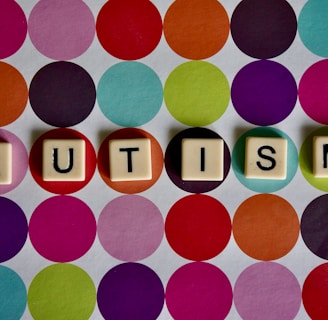Autism Awareness In the Workforce – How to make the Workplace More Accessible for Individuals on the Spectrum
AWARENESSLEADERSHIPBUSINESSCONFIDENCE
Karas Wright
4/9/20244 min read


April is Autism Awareness Month. This holds significant importance to me personally. I’ve spent years supporting Autism initiatives and was part of an executive team that raised over $800,000 in the early 2000s for autism groups in my local community. Initially, my interest was to help improve the awareness of school-aged kids on the spectrum. Having a child who’s on the spectrum this was monumentally important. However, my interest has shifted to advocacy for those who are adults on the spectrum. We’ve come a long way in the school system at the primary, secondary, and post-secondary levels to provide support.
There also have been strides to make businesses more accessible with “sensory shopping hours” with quiet time and lower light levels. However, there’s still room for improvement at the leadership level and HR level on how to support adults on the spectrum with adequate support in the workplace. In this article, I’ll cover what the Autism Spectrum is, what stigma individuals with autism face in the workplace, and provide some tips for how leaders can adjust their leadership approach to make the workplace more accessible.
According to the National Institute of Mental Health, “Autism Spectrum Disorder (ASD)is a neurological and developmental disorder that affects how people interact with others, communicate, learn and behave”. Most individuals are diagnosed in childhood, however, more and more individuals are being diagnosed with ASD later in life and into adulthood. ASD presents differently in individuals and has a variety of symptoms to varying degrees of severity. It can be diagnosed in any gender, race, ethnicity, or economic background and is a lifelong disorder. Common symptoms can be, and are not limited to:
Difficulty with eye contact.
Appears to not look at or listen to a person who is talking. Giving the impression that they may not be paying attention.
Not responding or being slow to respond and having difficulty with back-and-forth conversations.
Being unaware that they are talking at length about a subject and not able to identify that the listener has lost interest or would like to interject into the conversation.
Difficulty with social interaction or social situations.
Being overly focused on a subject.
Challenges with emotional regulation.
Being sensitive to sensory input ie: light, textures, sound clothing, etc.
Difficulty navigating sudden changes in routine.
This list above is not comprehensive, nor does it indicate that every individual on the spectrum has all of these. Nor does it indicate that they are unable to navigate the daily challenges they face in life, school, or work. Individuals with Autism often face discrimination in their lifetime, but as more media exposure about the vast diversity of the spectrum occurs there is progress. In the workplace, individuals can face challenges. High-functioning autistic individuals, such as individuals with ADHD/ADD, and Autism level I (formerly known as Asperger’s) are adept at doing the same work as neurotypical employees. However, they may have received comments from colleagues or leaders that they are not able to comprehend tasks or carry out instructions. It takes longer for them to navigate tasks.
They ask a lot of questions to clarify or understand. They may struggle with conforming due to what others may perceive as social awkwardness, resulting in shy behavior and not joining in on water cooler chat. They may struggle with deadlines, have working memory issues (with tasks that are not a personal interest), and thrive when they have clear expectations and procedures that provide clear guidelines of how to proceed. Individuals with ASD are highly creative, are strong auditory or visual learners, and may excel at math, music science, or art. They can have a unique perspective on projects, providing out-of-the-box thinking.
Leaders and HR coordinators can provide support to colleagues on the Autism Spectrum by asking questions to understand the strengths, areas of development, and support necessary to aid someone on the spectrum. Here are a few examples of what may be helpful:
Sensory support:
Allow adaptive hearing devices to suppress noise in the workplace ie: Loop earbuds, noise-canceling headphones, and sensory breaks if the noise level is too loud.
When coordinating workplace events, take into consideration the room setting advise the individual on the spectrum what to expect, and ask what accommodations are required.
Provide screen shields for monitors that may be too light or harsh.
Allow adaptive technology for speech-to-text or text-to-speech that will accommodate their unique learning style.
Meeting support:
Provide meeting agendas and set up meetings in advance so that there is time to prepare and adjust schedules.
Allow individuals to take notes, or leverage technology such as SCRIBBER or Otter.AI to write summaries that can be emailed out after the meeting.
Leverage cc captioning to allow for a multi-sensory input of meetings.
Encourage questions to allow the individual to translate information received into a language they understand.
Time management and organization support:
Encourage prep and wrap-up time to organize the day and ensure tasks are completed.
Suggest applications such as MindMeister or Notion to help with organizing thoughts, task management, and improving productivity.
Leverage calendars ie: google calendar, and Outlook to keep schedules organized.
Coaching support:
Have regular check-in meetings, weekly or biweekly. Check-in on progress, provide insights or guidance on progress, and address concerns early.
Provide clear communication on expectations and check in regularly. Be curious as to what their experience is and how you can close any expectation gaps and provide clarity.
Offer professional development opportunities for training, mentorship, improved communication, or networking that will help with career growth.
Be upfront with feedback and recognition. Be honest, forthright, and kind with feedback on what is working well and that you are there to support the employee’s growth and development.
Be aware that there may be slide-backs with growth and development. This work is hard for the individual as they’re outside their comfort zone. It doesn’t mean it’s beyond their capabilities. Having leaders who are committed to making the workforce accessible for employees is important to everyone’s success. Being aware of the diverse nature of the Autism spectrum, the impact of the stigmas faced in the workforce, and arming leadership with skills to make a safe work environment will make for a better place for all and is the hallmark of a strong workforce.
Karas is a person with high-functioning Autism and has a child on the spectrum. She’s spent 20+ years advocating for individuals who identify as neurodivergent. Building on the belief that everyone deserves a great boss, she believes that with the right support, individuals of all abilities can thrive.
coaching for lasting effectiveness and accountability
Contact Us
📧 info@wrightstepcoaching.com
📞 403-861-9917
© 2025. All rights reserved.


